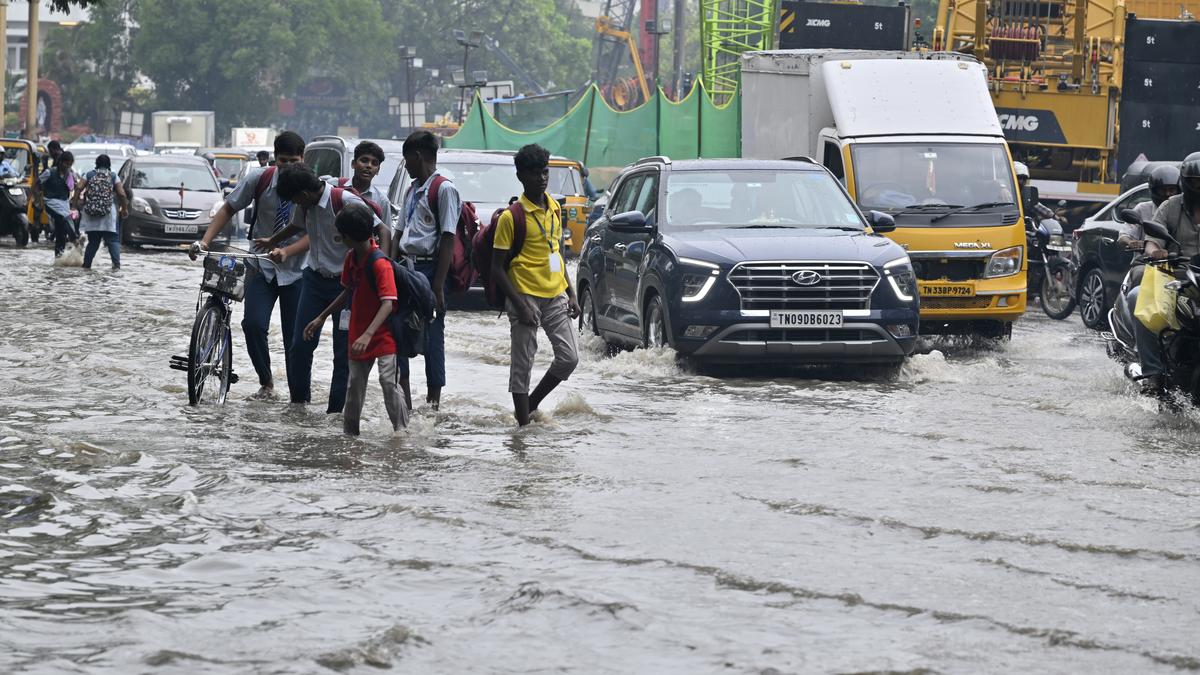Starting this week, a committee of technical experts has begun visiting city neighbourhoods to assess the impact of Chennai Metro Rail work on stormwater drains.
According to estimates, residents in more than 50 localities are likely to be affected by flooding this monsoon season due to ongoing metro rail work. Those living in areas such as Anna Nagar, T. Nagar, Kodambakkam, Porur, Otteri, Purasawalkam, Nungambakkam, and Thoraipakkam have demanded that civic agencies take measures to prevent flooding this Northeast monsoon.
Anna Nagar West Extension resident R. Kamaraj said that residents in the area have urged officials from the Greater Chennai Corporation (GCC), Chennai Metro Rail, and the Highways Department to restore the stretch damaged by metro rail work, from Koyambedu grade separator to Padi grade separator.
“The flood level reached four feet on roads such as East Main Road and North Main Road. Most of the residents living on the ground floor of our apartment complex have vacated due to the risk of flooding caused by metro rail work. Our complex has 48 apartments, 16 of which are on the ground floor. Ten of the 16 residents have already vacated. Expensive household items were damaged when water levels rose inside the houses during a rain spell lasting just 15 minutes. The problem of flooding has worsened only after metro rail work began in the area,” he said.
Otteri resident Madhan Kumar said that the construction of the Otteri and Purasawalkam metro stations has led to civic issues, particularly increased water stagnation in the area. “We request officials of the GCC and Chennai Metro Rail to improve coordination in order to prevent flooding of roads in the area. Once the roads are flooded, traffic comes to a standstill in these already congested areas,” he said.
‘Pave roads ahead of monsoon’
Nungambakkam resident R.B. Saravanan said officials should ensure that all roads near metro rail construction sites are properly paved ahead of the onset of the Northeast monsoon. “We are worried about flooding this year. Civic agencies should prevent flooding on stretches such as Sterling Road in Nungambakkam. In previous years, the stretch from Vadapalani to Kodambakkam was slushy due to metro rail work. Motorcycle riders avoided the stretch during the monsoon. After the roads were paved, the civic issues were resolved to a great extent. They should not dig up the roads again before the onset of the Northeast monsoon,” he said.
A section of residents demanded that the GCC and Chennai Metro Rai take preventive measures during the Southwest monsoon season too, starting this month, pointing to the civic issues reported in various stretches during the recent spell of rains.
A. Francis, a resident of Ward 193 in Thoraipakkam, said that residential neighbourhoods in the area have reported an increase in civic issues caused by water stagnation since metro rail work began along Rajiv Gandhi Salai.
“Water stagnation on Rajiv Gandhi Salai is very common during the rainy season. But after the metro rail work started, the stormwater drains were closed. After a spell of rain, water stagnation in Seevaram and Thoraipakkam has increased, and so has traffic congestion. Students and office-goers have been suffering a lot,” he said.
Ward 104 councillor T.V. Shemmozhi said residents have requested the civic authorities to prevent flooding on Jawaharlal Nehru Salai by addressing the civic issues caused by metro rail work. “During floods caused by the metro rail construction, the Anna Nagar West bus depot gets inundated, preventing buses from entering. The police station in Thirumangalam was also flooded during the previous Northeast monsoon due to the ongoing work. We cannot wait any longer. The Highways Department is not carrying out the necessary work, as metro rail construction is still under way,” he said.
Expert recommendations
N. Mathavan, who developed the first resilience index for Chennai, said the civic body should find ways to resolve issues related to the blockage of water flow caused by barricades erected on road medians, and improve the resilience of residential areas near metro rail stations before the onset of the Northeast monsoon.
Experts pointed to poor design of civic infrastructure projects, particularly flyovers such as Porur flyover, that have led to persistent civic issues without a solution. If officials decide to raise the road level to prevent flooding at the Porur junction, then heavy vehicles will not be able to pass underneath the flyover. So, engineers of various civic agencies have been working consistently hard to find a solution to the problems arising at the metro rail construction sites.
Anna University former professor of Urban Affairs K.P. Subramaniam said: “A holistic approach is needed to prevent or reduce flooding at CMRL sites. The bottom line is effective coordination among the government agencies for urban development and governance, such as CMRL, GCC, CMDA, CMWSSB, and others. While selecting the site for metro stations, particularly, underground stations, its topographical and hydraulic characteristics should be taken into consideration. In the Delhi Master Plan, the floodplains, inundation areas, catchment areas have been classified as Zone 0 (no development zone). The CMDA can emulate such examples. Rapid and unplanned urbanisation is another important factor.”
Published – June 06, 2025 10:30 am IST





















